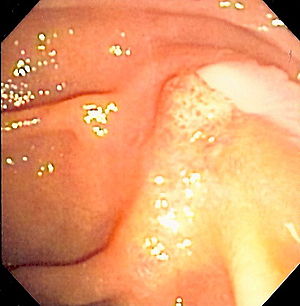Ascending cholangitis
| Ascending cholangitis | |
|---|---|
 |
|
| Duodenoscopy image of pus extruding from Ampulla of Vater, indicative of cholangitis | |
| Classification and external resources | |
| Specialty | gastroenterology |
| ICD-10 | K83.9 |
| ICD-9-CM | 576.1 |
| DiseasesDB | 2514 |
| MedlinePlus | 000290 |
| eMedicine | emerg/96 med/2665 |
| Patient UK | Ascending cholangitis |
| MeSH | D002761 |
Ascending cholangitis, also known as acute cholangitis or simply cholangitis, is an infection of the bile duct (cholangitis), usually caused by bacteria ascending from its junction with the duodenum (first part of the small intestine). It tends to occur if the bile duct is already partially obstructed by gallstones.
Cholangitis can be life-threatening, and is regarded as a medical emergency. Characteristic symptoms include yellow discoloration of the skin or whites of the eyes, fever, abdominal pain, and in severe cases, low blood pressure and confusion. Initial treatment is with intravenous fluids and antibiotics, but there is often an underlying problem (such as gallstones or narrowing in the bile duct) for which further tests and treatments may be necessary, usually in the form of endoscopy to relieve obstruction of the bile duct. The word is from Greek chol-, bile + ang-, vessel + -itis, inflammation.
A person with cholangitis may complain of abdominal pain (particularly in the right upper quadrant of the abdomen), fever, rigors (uncontrollable shaking) and a feeling of uneasiness (malaise). Some may report jaundice (yellow discoloration of the skin and the whites of the eyes).
...
Wikipedia
